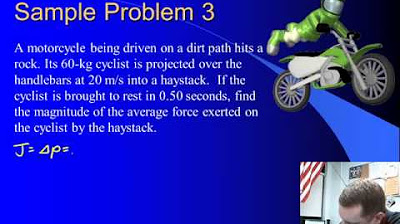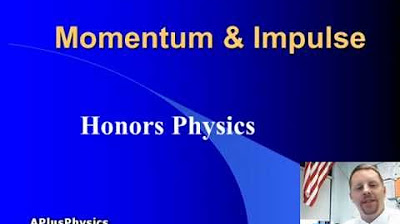College Physics 1: Lecture 26 - Impulse and Momentum
TLDRIn this physics lecture, the concept of impulse and momentum is explored, focusing on their relationship and application to collisions. Impulse is defined as the area under the force versus time graph during a collision, and its unit is Newton-second, though kilogram meter per second is preferred for consistency with momentum. Momentum, mass times velocity, is introduced as a vector quantity, and the Impulse-Momentum Theorem (J = Δp) is highlighted, illustrating how impulse leads to a change in momentum. Examples, including a rubber ball bouncing and a sled's speed change with rocket thrust, demonstrate the theorem's practical use. The lecture concludes with an emphasis on the theorem's significance and its application in real-world scenarios, such as the strategy of hedgehogs to cushion falls and the technique of catching water balloons.
Takeaways
- 🚀 Impulse and Momentum are key concepts in physics, particularly relevant during collisions where objects interact briefly.
- 🔍 Impulse is defined as the area under the force versus time graph during a collision and is represented by the letter 'J'.
- 📊 The impulse can be calculated using the average force applied over the duration of the collision, simplifying the process without needing integral calculus.
- ⚖️ Impulse has units of Newton-seconds (N·s), but the preferred unit is kilogram-meters per second (kg·m/s), aligning with the units of momentum.
- 📚 Momentum is defined as mass times velocity (p = mv) and is a vector quantity, having both magnitude and direction.
- 🔄 The Impulse-Momentum Theorem states that the impulse applied to an object is equal to the change in its momentum (J = Δp).
- 🛡️ Hedgehogs use the principle of impulse and momentum to reduce impact by landing on their cushioned spines, increasing the collision time and decreasing the average force.
- 🎈 Catching a water balloon gently by following through with the motion can increase the collision time, thus reducing the force exerted on the balloon and preventing it from bursting.
- 📉 The equation Δp/Δt equals the average force experienced during a collision highlights the relationship between collision time and force.
- 📚 An example problem demonstrates how to use the Impulse-Momentum Theorem to calculate the final velocity of a sled with rocket engines, emphasizing the theorem's practical applications.
- 📝 The lecture concludes with questions that reinforce the understanding of impulse, momentum, and their vector nature, emphasizing the importance of direction in calculations.
Q & A
What is the primary focus of the lecture?
-The lecture primarily focuses on the concept of momentum and its relation to impulse, Newton's Second Law, and the conservation of momentum in physics.
What is considered a collision in the context of this lecture?
-A collision is defined as a brief interaction between objects, which can involve two or more objects colliding at the same time.
How is the impulse during a collision typically represented in the lecture?
-The impulse during a collision is represented as a force that changes over a short duration, often quite large, and is depicted as an increasing and then decreasing force on a force versus time graph.
What is the definition of impulse in the context of physics?
-Impulse is defined as the area under the force versus time graph during a collision, and it is represented by the letter J.
How can the impulse be simplified for calculation purposes?
-The impulse can be simplified by considering an average force applied over the same duration as the actual changing force, creating a rectangle under the force versus time graph whose area can be easily calculated.
What are the units of impulse and why is kilogram meter per second preferred?
-The units of impulse are Newton second, but the preferred unit is kilogram meter per second because it matches the units of momentum, simplifying calculations and comparisons.
What is the relationship between impulse and momentum?
-The relationship between impulse and momentum is given by the impulse-momentum theorem, which states that the impulse delivered to an object is equal to the change in its momentum (Δp).
Why is the equation Δp/ΔT significant in real-world applications?
-The equation Δp/ΔT is significant because it implies that increasing the time of a collision (ΔT) will decrease the average force experienced during the collision, which has practical applications in safety and impact reduction.
Can you provide an example from the lecture that illustrates the impulse-momentum theorem?
-An example from the lecture is the hedgehog falling from a tree. By curling into a ball and landing on its spines, the hedgehog increases the time of collision, which according to the impulse-momentum theorem, reduces the average force of the impact and cushions the fall.
What is the final speed of a 500 kg sled coasting at 20 m/s that turns on its rocket engines for 5 seconds with a thrust of 1000 Newtons?
-Using the impulse-momentum theorem, the final speed of the sled is calculated by adding the initial velocity (20 m/s) to the change in velocity caused by the thrust (1000 N * 5 s / 500 kg), resulting in a final speed of 30 m/s.
Outlines
📚 Introduction to Impulse and Momentum
The lecture begins with an introduction to the concepts of impulse and momentum, which are pivotal in understanding collisions. It emphasizes that momentum is a fundamental concept in physics, related to impulse and Newton's Second Law. The lecture also introduces the idea of conservation laws and how momentum is conserved. The material is connected to previous topics, with a focus on the force experienced during collisions and how it changes over time, defining impulse as the area under the force versus time graph.
📐 Calculating Impulse and Average Force
This paragraph delves into the calculation of impulse, which is defined as the area under the force curve over time. It simplifies the concept by introducing the idea of an average force over the same time period, leading to a rectangle whose area can be easily calculated. The unit of impulse is derived from the units of force and time, resulting in Newton-seconds or, more commonly, kilogram meters per second. The paragraph also clarifies that impulse is a vector and discusses its directionality. An example problem is presented, involving a rubber ball bouncing off the floor, to illustrate the calculation of impulse and average force.
🚀 The Impulse-Momentum Theorem
The paragraph explains the relationship between force, impulse, and momentum during a collision. It expands on Newton's Second Law to show that the impulse (the average force times the time interval) is equal to the change in momentum (final momentum minus initial momentum). This leads to the Impulse-Momentum Theorem, which states that the impulse applied to an object is equal to the change in its momentum. The units of momentum are discussed, highlighting the importance of using kilogram meters per second as the unit for both impulse and momentum, ensuring consistency in calculations.
🧲 Understanding Momentum as Mass Times Velocity
The concept of momentum (P) is defined as the product of an object's mass (M) and its velocity (V), resulting in the unit of kilogram meters per second. The paragraph emphasizes that momentum is a vector quantity, having both magnitude and direction. It provides a table to give students a sense of the momentum values for various objects, ranging from a falling raindrop to a car on the highway, to help them understand the concept better. The Impulse-Momentum Theorem is simplified to J = ΔP, showing that impulse results in a change in momentum.
🛡️ Applications of the Impulse-Momentum Theorem
The lecture discusses real-world applications of the Impulse-Momentum Theorem, particularly how increasing the time of a collision can decrease the force experienced. Examples include hedgehogs falling from trees and the act of catching water balloons. The theorem is then applied to a problem involving a sled with a rocket engine, showing how to calculate the final speed after the engine is turned on for a certain duration. The problem illustrates the practical use of the theorem in determining the change in velocity due to an applied force over time.
🔍 End of Lecture Questions
The lecture concludes with questions that test the understanding of impulse and momentum. The first question involves comparing two force versus time graphs to determine which one delivers a greater impulse. The second question asks for the calculation of the change in momentum (Δp) for a cart, emphasizing the importance of considering direction in vector calculations. The answers are provided, with a reminder to be mindful of the vector nature of momentum and the impact of direction on calculations.
Mindmap
Keywords
💡Impulse
💡Momentum
💡Collision
💡Newton's Second Law
💡Conservation Laws
💡Force
💡Average Force
💡Compression
💡Impulse Momentum Theorem
💡Vector
Highlights
Introduction to the concept of impulse and momentum in relation to collisions.
Impulse is defined as the brief interaction force during collisions, which can be more complex than a single value.
The graph of force versus time during a collision shows how force changes over a short duration.
Impulse is calculated as the area under the force versus time graph, which can be simplified using average force.
Impulse has units of Newton Seconds, but kilogram meter per second is preferred for consistency with momentum units.
Momentum is defined as mass times velocity (MV) and is a vector quantity.
The impulse-momentum theorem states that impulse (J) equals change in momentum (Δp).
Increasing the time of a collision can decrease the average force experienced, as demonstrated by hedgehogs falling from trees.
The equation Δp/ΔT shows the relationship between collision time and average force.
Example problem: Calculating impulse and average force on a bouncing rubber ball.
The importance of understanding the direction of vectors when calculating momentum.
A table of different objects and their average momentum to provide perspective on expected values.
The application of the impulse-momentum theorem in real-world scenarios like catching water balloons.
Solving an example problem involving a sled's change in velocity due to rocket engine thrust.
End of lecture questions to test understanding of impulse, momentum, and their applications.
Conclusion and transition to the next lecture topic: conservation of momentum.
Transcripts
Browse More Related Video

Introduction to Impulse & Momentum - Physics

2022 Live Review 5 | AP Physics 1 | Understanding Impulse and Momentum

High School Physics - Impulse-Momentum Theorem

High School Physics - Momentum & Impulse

College Physics 1: Lecture 27 - Conservation of Momentum

What Are Momentum and Impulse? | Physics in Motion
5.0 / 5 (0 votes)
Thanks for rating: